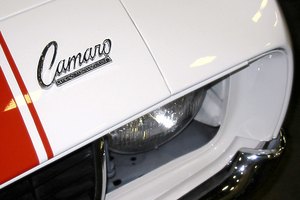1984 Honda Gold Wing GL1200 Specs
by Michael G. SanchezPowerful and luxurious, the Gold Wing 1200 debuted for the 1984 model year. The third-generation Gold Wing model, it was Honda's response to an increasingly competitive market for large, long-distance-focused Japanese motorcycles. When the original Gold Wing debuted in 1975, it essentially invented the touring category. By the mid-1980s, though, a number of formidable competitors were jumping into the market, including the Yamaha Venture, Suzuki Cavalcade and Kawasaki Voyager. The Gold Wing 1200 wasn't radically different from its highly successful predecessor, but it improved on it in nearly every significant category.
A Refined Chassis
The third-generation Gold Wing was built on a stronger, more rigid frame. The base model had the same same dry weight as its predecessor: 599 pounds. The mid-range Interstate model weighed 697 pounds and the top-of-the-line Aspencade version tipped the scales at 723 pounds. The Gold Wing 1200 featured smaller-diameter wheels and wider tires relative to the previous-generation model, which made for improved handling and a more nimble, maneuverable feel. The steering head was moved back and lowered to further improve handling. The Gold Wing 1200 had a 63.4-inch wheelbase and its seat height was 30.7 inches. It wore a 130/90 front tire and a 150/90 rear tire.
More Power, Less Maintenance
The 1984 Gold Wing 1200 was powered by an updated version of the same boxer four used in the previous-generation model. Thanks to the addition of a hydraulically actuated clutch and hydraulic tappets for the valves, the new model required less maintenance. The engine displaced 1,182 cc and produced 94 horsepower at 7,000 rpm and 77.4 foot-pounds of torque at 5,500 rpm. That was enough thrust to get the big Honda up to a top speed of 118 mph. Power was sent to the ground via a five-speed transmission and shaft final drive.
Trim Levels: From Simple to Feature-Packed
The 1984 Gold Wing base had no fairing. The mid-range Interstate model, on the other hand, was a "full dresser," which meant that it was almost entirely encased in plastic panels. The Interstate also added an easy-to-read, car-style instrument panel. The range-topping Aspencade version added a premium Panasonic AM-FM-cassette stereo, a driver-passenger intercom, an LCD instrument panel, a special rear light bar and foot boards for the passenger instead of foot pegs. Following the 1984 model year, the un-faired standard Gold Wing model was phased out. All Gold Wings had fairings from 1985 on.
Pricing
The 1984 Gold Wing started at $4,795 for the base model, $6,195 for the Interstate and $7,895 for the Aspencade.
Writer Bio
Michael G. Sanchez has been a professional writer for over 10 years. A lifelong car enthusiast and former senior mechanic, he has written on a wide range of automotive topics. He holds a bachelor's degree in English literature from Castleton State College. Sanchez started writing about cars as a part-time copywriter for a local dealership while still in high school.


